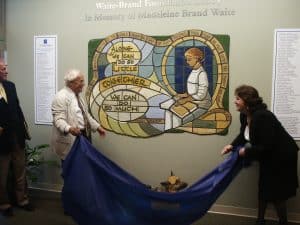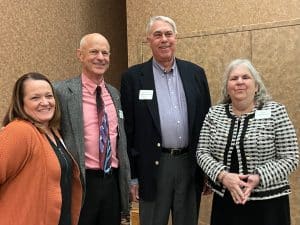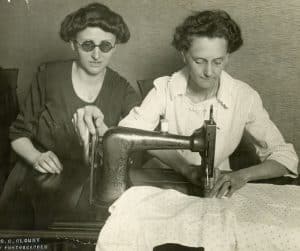100 Years InSight
On November 2, 2023, The Sight Center celebrated 100 years of service to Northwest Ohio.
Voices of the Past
This vignette tells the story of our founding with the very words of the time.
Featuring quotes from Joseph F. Clunk, Edward E. Evans, Frank Saxton, Dr. Harry S. Will, and Grace Jamison. It also features newspaper excerpts from the Toledo Times (October 14, 1923) and the Toledo Blade (October 24 and November 21, 1923).
Includes the voices of Bob Ulm, Cliff Smithers, Jacob King, Adam Ragle, Tim Tegge, and Meghan Ragle
Madge Levinson
Madge Levinson was a long-time Volunteer Coordinator for The Sight Center. She was also instrumental in the Sight Center Audio Network (SCAN)- the radio reading service that ran from 1989-2006. Madge was a huge part of not only The Sight Center, but organizations such as the Toledo Rep and WGTE. In honor of Madge we shared her commercial for us from 2010.
Dr. Carol Kollarits Wins the 2023 John Goerlich Distinguished Service Award.
In 1984 The Sight Center Board of Trustees created the John Goerlich Distinguished Service Award to be given annually to a person who has unselfishly. served the blind and visually impaired communities. The Award is named for Mr. John Goerlich whose substantial personal and philanthropic contributions have allowed The Sight Center to flourish for many years.
While nominees must satisfy at least one of several criteria, Dr. Carol Kollarits was selected this centennial year for having satisfied ALL of them, including:
- Significant contributions to the cause of sight preservation.
- Outstanding service to the blindness and low-vision community
- Creating opportunities to improve the well-being of blind or low-vision individuals
- Significant financial or tangible contributions to The Sight Center and its mission
Dr. Kollarits has dedicated her entire adult life to vision preservation and serving the blind and low-vision communities with her time, treasure, and substantial talents.
Four Executive Directors Together
It was exciting to see four of The Sight Center’s Executive Directors in one spot!
Pictured above are Stacey Franks (2014-2022), Tim Tegge(2022- ), Barry McEwen (1978-1995), and Dawn Christensen (2006-2014).
100 Glimpses: 1923
Throughout the coming year we will be sharing “Glimpses” of our rich history. This is the premiere episode, briefly touching on the happenings of a 1923 Toledo and a preview of our history. Featuring the voice of London Mitchell. Follow us on Facebook or subscribe to us on our YouTube channel for the latest videos.
A Stroll Through the Decades
The following pictures were included as part of our “A Stroll Through the Decades” exhibit.
Each picture represented a different aspect of services. Included are detailed descriptions of the context of each image.
1920s: Home Teaching
Helen Lapp was a “home teacher for the blind” for the Ohio Commission for the Blind (now Opportunities for Ohioans with Disabilities, which oversees the Bureau of Services for the Visually Impaired). She oversaw 18 counties, including Lucas County. She was also the first president of the “Happy Times” club. Here she is instructing Mrs. Miller on how to sew using a machine in 1925.
Helen instructed students how to sew, crochet, and knit so they could make an income. She also taught Braille and the Moon System of touch reading. The Moon System was an alternate form of braille that incorporated raised lines and curves in addition to dots.
Pictured: Helen Lapp (left) guides Mrs. Miller’s (right) hand on the sewing machine.
1930s: Talking Books
The Talking Book program began to take flight in 1934. This program, started by the Library of Congress, sent record players to individuals. Participants were able to listen to books recorded on records. Toledo was one of the first regions to participate in this national program.
For a time, The Society was the region’s distributor for the machines, which were dispersed from the agency’s offices. The Volunteer Telephone Pioneers of America completed repairs.
Pictured: Toledo Society for the Blind clients listen to the agency’s first machine, which cost $30- which is about equivalent to $684 today. The service has always been free for the participants of the program.
1940s: War Effort
During World War II Americans did whatever they could to contribute to the war effort and The Toledo Society for the Blind was no exception. From 1943 to 1945, the workshop was subcontracted through the Ohio & Michigan Paper Company. Twenty-five employees folded hundreds of thousands of waterproof liners. These liners were used to ship materials overseas.
Other workshop employees were assigned additional tasks that helped the war effort. During this time, the workshop’s revenue met an all-time high.
Pictured: 3 women fold giant pieces of liner paper.
1950s: Sheltered Workshop
During the 1950s The Toledo Society for the Blind’s sheltered workshop expanded to have more industrial contracts. In addition to sorting car parts for AP Parts, the workshop also had contracts for Owens Illinois, Sears, Ford, and other businesses.
Pictured: Former board president Edward E. Evans and newly appointed president John Goerlich (both on the left) visited two workers (on the right) in the workshop in 1958.
1960s: Orientation and Mobility
In 1968 The Toledo Society for the Blind launched its Mobility Training Program. Rosalyn Snow became our organization’s first trained mobility instructor. Rosalyn completed a 2-month course at Arkansas Enterprises for the Blind under the tutelage of Oliver Burke. At the time, the nearest training facilities were in Columbus and Pittsburgh.
Each of the Society’s “students” had to complete 60-100 hours of training before they would graduate. Upon completion of the program, they would receive their “solo wings”- a pin of a white cane with wings on it.
Pictured: Rosalyn Snow (right) oversees Ginny Place (left) as she exits the Society’s mobility bus.
1970s: Focus on Rehabilitation
Rehabilitation and Daily Living Skills assist clients in living their best lives. In 1970 the agency added the Techniques of Daily Living Center- a fully functioning apartment. This center provided an accessible space where clients learned adaptive strategies to accomplish daily tasks like laundry, cooking, and cleaning.
Pictured: Gail Sheffield oversees a client using a mirror to put on makeup.
1980s: SCAN
The Sight Center Audio Network, also known as SCAN, was inaugurated on March 27, 1989. The goal of the service was to be “the vocal eyes of Northwest Ohio.” Volunteers would read local newspapers and announcements. The broadcasts were available on the second audio program channel (SAP) on WBGU and WGTE, making SCAN the reading service with the biggest reach in the United States. The program ran until 2006.
Pictured: Madge Levinson (right) prepares the news as a volunteer (left) gets ready to go on the air.
The Sight Center’s Low Vision Clinic first opened in October 1992. To this day the clinic’s goal is to assist individuals in using their remaining sight to the best of their ability- using a combination of devices, training, and adaptive strategies to empower clients to reach their goals for independence.
Pictured: A doctor on the right examines a young patient.

2000s: New Building for a New Century
Dedicated on June 17th, 2007, our current building was planned with our clients in mind. The welcoming space ushers guests efficiently from check-in through the entire evaluation. One of the major reveals that day was the debut of the Helen Keller Mosaic- this tactile art piece was built in our lobby, by local artist Sister Jane Mary Sorosiak- who has produced artworks for numerous other locations, most prominently Lourdes University.
Pictured: John Davies (left) and Dawn Christensen (right) pull the blue cover sheet off the mosaic.
2010s: The Shop
When the door to The Shop at The Sight Center first opened on March 31, 2015, under the leadership of Executive Director Stacey Butts, the goal was to make it easier for people who are blind or visually impaired to get the tools that help them live independently. Stocked full of magnifiers, specialty lamps, handy gadgets, high-tech devices, talking products, and so much more, The Shop quickly became a destination for many who live with permanent vision loss. Located in a simulated apartment, The Shop offers products that can be tested in real-life settings and demonstrated on actual household devices. Today, The Shop at The Sight Center and The Shop Online provide solutions to thousands of people throughout our service area and nationwide.
Pictured: A large, open-concept apartment-style room, with an adjoining kitchen filled with assistive devices.
For even more pictures and stories check out our Flickr account here.













